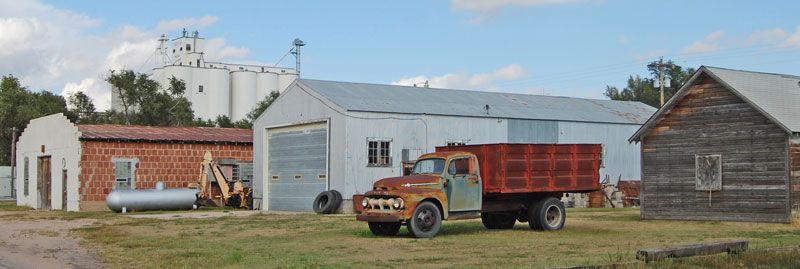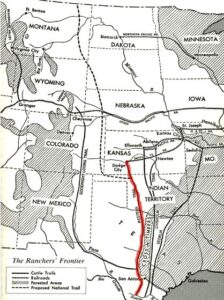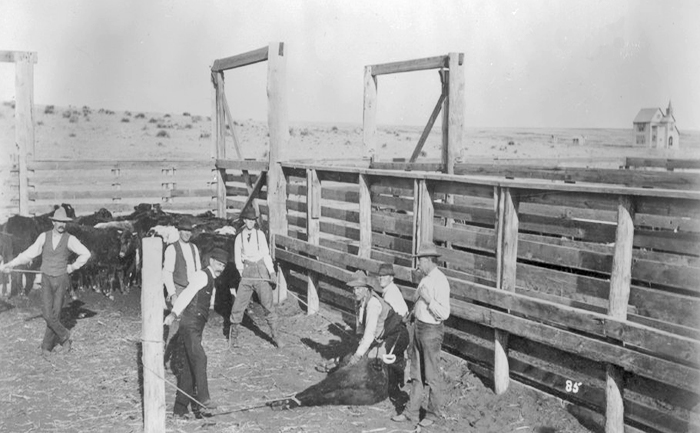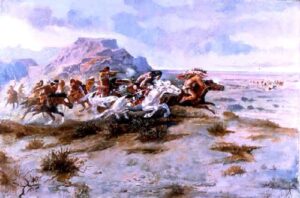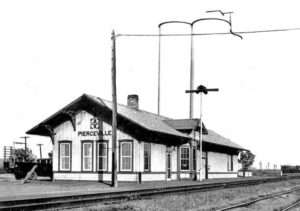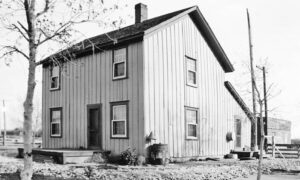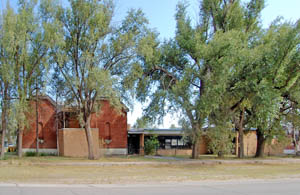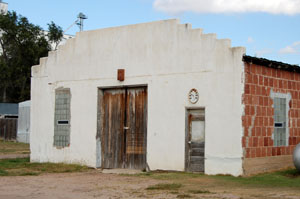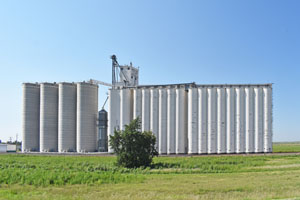Pierceville, Kansas, is an unincorporated community in Finney County. It is officially also an extinct town as it no longer has a post office. It is the only town in Finney County that has its original name and location. As of the 2020 census, the population of the community and nearby areas was 98.
Cattlemen created Pierceville in the early spring of 1872 when the Barton Brothers drove 3,000 head of cattle up from southern Texas over the Great Western Trail. They were the first to bring in a trail herd to feed on the government ranges in western Kansas. That fall, the Barton Brothers reached the present site of Pierceville with their herd and established ranch headquarters in dugout buildings along the Arkansas River. This was about three years before Dodge City was to become a center of the early cattle industry
When it was founded, it had the distinction of being farther out into the wilderness than any of the frontier towns in southwest Kansas. In all the vast area west of Fort Dodge and for many miles into Colorado, Pierceville stood as the white man’s only outpost. Just across the river in the sand hills lay the gruesome remains of a large wagon train which the Indians had attacked and destroyed several months before. Not a soul had been left alive to tell the story. Strewed over the ground were the bones of man and beast, and many of the wagons had been burned. A man named Emerson later salvaged the ruins. He hauled three carloads of old chains and scrap iron to Dodge City and had about 35 good wagons left. With these, he started a freight train from Dodge to Fort Elliott, Oklahoma.
Herds of long-horn cattle were grazing in the valley when the Atchison, Topeka & Santa Fe Railroad surveyors came along driving stakes to mark their right-of-way to the state line. The Barton Brothers ranch headquarters was chosen by Santa Fe officials as a railroad townsite and was named in honor of Charles W. and Carlos Pierce, members of the original Atchison, Topeka & Santa Fe Railroad Company.
As soon as the survey was complete, gangs of construction men were put to work. A pump was put down, and a windmill was attached for power to supply water for the Santa Fe engines. In case of a calm spell of weather without enough wind to turn the mill, a supply of water was always kept stored in a wooden tank. Thomas O’Louglin put in the first store about the time the railroad was completed through Pierceville and traded provisions or buffalo meat, which he, in turn, traded to wholesalers for provisions, clothing, and ammunition. He kept everything to make the place a popular resort for hunters, cowboys, section crews, and adventurers who happened to be in that region. A Commissariat was established at Pierceville, and 500 workmen were fed and bunked there in box cars. Hired hunters supplied meat from the herds of buffalo and antelope that ranged in the plains.
A post office was established on June 10, 1873, with George B. Clossen as postmaster.
There were several dugouts in the town, most of which had been built to shelter soldiers who had been stationed there.
At this time, Pierceville was in a good position to out-rival Dodge City for the title of Cowboy Capital, for the first trail herds brought into western Kansas came down the Arkansas River from the west. The lush grass was tall, and the river ran bank full, never having been drained by irrigation canals. Trappers glided quietly along the river channel in strings of row boats, gathering many fine pelts from the beavers along the banks.
For a year, the town flourished. Then, July 3, 1874, dawned clear and bright. As residents began to wonder if any cowboys would come in to help celebrate Independence Day, some buffalo hunters came racing into town on horseback, bringing news of the fight at Adobe Walls, Texas, and reported that a band of defeated Indians was heading north, making for the settlements along the Santa Fe railroad.
The next morning, the Indians came decked out in war paint, and the town was abandoned to them. It was sacked and burned to the ground. Just as the Indians were starting for the river, with a sharp blast of its whistle, a Santa Fe train came puffing into view. The painted warriors raced down on their horses to meet it and then gave chase. The train never stopped. The Indians shot their arrows and pistol bullets through the windows of the coaches. The engine steam whistle shrieked in an effort to scare off the horses, and the train never slowed down.
It was learned afterward that these same Indians had attacked a family named German, killing the father, mother, son, and a little child, and took captive four girls. They had them when they passed through Pierceville, but they were rescued later. Pierceville is the only town in Southwestern Kansas ever attacked by the Indians. This event occurred before Garden City was even born.
For the next four years, no effort was made to rebuild the town. The site was used only by roving bands of Indians or drivers of trail herds as a camping ground.
Finally, in 1878, John M. Stowe built a dwelling, and Mr. Vermillion established a store. The post office reopened on July 24th with Richard E. Welch as postmaster. However, the frontier tide had rolled on westward, and more towns had sprung up farther on. However, Pierceville had the only coal chute, and settlers came for many miles to get coal and do their trading.
In 1879, many claims were taken around Pierceville, and several business enterprises were begun in town. William Harvey operated a general store in the Vermillion building; R. W. Sholes had a general store; William C. Newlin opened a real estate office, and John Brown was the village blacksmith. Other prominent men were M. R. Logue, N.J. Collins, and George Wallace.
The Barton brothers operated a ferry across the Arkansas River during those years, which made it possible for people south of the river to trade at Pierceville. They could haul a load of four tons and made trips whenever teams and wagons or horsemen appeared on the opposite bank and hailed the ferry.
By 1879, the railroad had a wooden tank that was supplied by water from a windmill. Shortly after this, coal chutes were built, and a pumping system was installed to pump water into the tank by horsepower. Both were crude affairs but answered the purpose at that time. George Wallace was employed as foreman of the coal chutes and also operated the pumping plant. There was no railroad station agent at that time, and each railroad crew had one member who was a telegraph operator and, in this way, received orders by attaching their telegraph instruments to a wire.
During the summer of 1879, N.J. Collins, an educated and cultured man with a modest amount of wealth, built “The Summit,” a 12-room, three-story house above a full-story basement of native rock. He had come west from New York with the ambition of establishing a great wheat ranch. A spacious portico extended from each story, and he painted the building white. Standing on the hill overlooking Pierceville on the north, it towered like a castle above the plains, which were mostly barren of comfortable dwellings or even trees. That fall, Collins planted 100 acres of wheat. But there was no rain, and it never came up. The hot winds continued to blow all during the next year, and the drought showed no signs of abating. He had a vision that it was going to take a long time to tame the wild sod and the still wilder climatic conditions. His ambition to be a farmer left him, and he moved to Dodge City and devoted the rest of his life to preaching the word of God.
For the next few years, the big house stood empty and served only as a landmark for people traveling through the country. Reports were circulated that the house was haunted. Its flapping shutters and swinging doors appeared to be moved by unseen hands. Even those in dire need of shelter shunned the place. But during the boom of 1886, the problem of housing the boomers became so acute that someone conceived the idea of making it into an apartment house. Four families of newcomers, who knew nothing of the ghostly rumors connected with the place, were comfortably and happily sheltered there. However, the boom of ’86 didn’t last long, and the boomers left the country faster than they had come in. Once more, The Summit was deserted. During succeeding years, the house gradually fell to pieces, and the material was hauled away to use in other buildings.
Pierceville was platted and grew to a population of 400 in the boom of 1886. There was a weekly newspaper called the Pierceville Courier, managed by H B. Brown; Mrs. John Clark operated a hotel; Cory & Newman ran a hardware store; Orr & Stapelton sold lumber; J. A. Hurd was in the harness business; J. R. Drillinger operated a restaurant and rented rooms; and A.S. Van Patten, who came from New York in 1879 engaged in ranching and operated the Laclede hotel. Professionals included G. L. Ensign, surveyor; G. W. Wright, real estate; David A. Armstrong, painter; Don Proseaux, doctor and druggist; Mr. Grub, carpenter; D. McDonnel, blacksmith; and John Clark, section foreman.
In the fall of 1886, the Barton Ferry started across with five tons of coal. There was a strong wind blowing, and in spite of its big load, the boat was carried along at a rapid rate. The sail was dropped as usual when within 30 feet of the bank, but the boat failed to stop and shot clear over the bank, wrecking it beyond repair. At this time, a bridge was built across the Arkansas River, and a road opened south.
Afterward, Pierceville’s population slacked off again.
In 1910, Pierceville was still located on the Atchison, Topeka & Santa Fe Railroad and had general stores, hotels, schools, churches, express and telegraph offices, and a money order post office. The population in 1910 was 150. By then, a steel and concrete bridge had replaced the old wooden structure over the Arkansas River.
New and modern school buildings were built in the next years, including a brick grade school with two rooms and a large basement auditorium.
It was voted on July 12, 1919, that bonds be issued to build a rural high school, not to exceed $17,000, and a good fire-proof building was erected. Three teachers were employed in the high school and two in the grade school.
By 1930, the population was 166, and in the next decades, the population continued to fall.
Pierceville’s post office closed on April 11, 1992.
Today, Pierceville still has a few houses, a community building, an empty elementary school, a grain elevator, and a church.
The community is served by Garden City’s USD 457 public school district.
It is located along U.S. Routes 50 and 400, 12 miles southeast of Garden City.
©Kathy Alexander/Legends of Kansas, September 2023.
Also See:
Extinct Towns of Finney County
Sources:
Blackmar, Frank W.; Kansas: A Cyclopedia of State History, Vol I; Standard Publishing Company, Chicago, IL 1912.
Blanchard, Leola Howard; The Conquest of Southwest Kansas, Wichita Eagle Press, 1931.
The Pierceville Courier newspaper, May 14, 1886, to 1887
Finney County by the Kansas Historical Society, 1950
Garden City Telegram September 1949
Wikipedia

